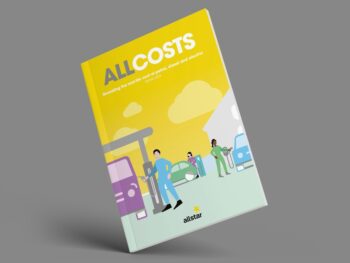Charging in public can cost over 20 times more, reveals new Allstar report
Drivers could be spending more than twenty times as much recharging their electric vehicle at public charge points compared to the cost of charging from their homes, a new report from Allstar reveals.

Real-time and real-life insights from Allstar reveal the true cost of petrol, diesel fuelling and EV charging
The new and exclusive AllCosts report takes proprietary data from millions of fuel transactions and hundreds of thousands of on-the-road charging events throughout the Allstar network along with at-home charges.
Said to be the first of its kind, the report is being published quarterly to provide businesses and fleets with real-life costs for electric, petrol and diesel vehicles on-the-road today.
Key findings from the first edition include that home tariffs can be as low as 4p per kWh while public rates can exceed £1 – over 20 times as much. On average, drivers often pay more than twice as much per kWh to charge in public compared to at home.
Beyond tariffs, there are other factors behind the numbers, such as how long a driver can use an ultra-low tariff at home and if they would need to charge at peak rates in order to complete a full charge. Drivers and fleet managers must also consider how fast the most expensive public chargers are and if paying more to get back on the road much quicker is of greater benefit to the business than the energy cost.
The Allstar AllCosts report also shows that diesel and petrol prices have been falling, and reveals the pence-per-mile costs of various fleet vehicle types based on real-life fuel and energy data.
It also provides analysis of average public charging costs, using data held by Allstar of 69 regions throughout the UK, and found that driving an EV in rural areas is often either more expensive than urban ones, or the cheapest in the country. Among the 10 cheapest areas for charging were Norfolk, Cornwall, Belfast, Orkney and the Isle of Wight.
Of the top 10 of most expensive areas to charge, Bristol was the only urban centre, with Scottish areas heavily represented too. Greater London is the busiest area for plugging in, with more than four times as much public charging than the next highest, Greater Manchester.
The report draws on insights generated by Allstar Chargepass, which simplifies payment for EV charging, both at home and on the road, and can be used by both electric and mixed fleets.
Ashley Tate, MD, Allstar Chargepass UK, commented: “As an industry, we are collectively migrating to alternative power for vehicles, which is a huge moment in the history of mobility. With that comes plenty of questions around the various running costs, so we’ve harnessed our proprietary data to provide clear insights and help drivers get a better understanding of real-life costs of electric vehicle charging, petrol and diesel.
“For those that are opting for EVs, our inaugural edition has shown the clear cost benefits of charging at home. While we understand that this isn’t an option available for everyone, where possible drivers could make significant savings by charging at home compared to those using public charge points.”
“We’ve provided the pence-per-mile figures of cars and vans in the report based on our real-life electric and fuel costs so that businesses and fleets can see our estimated indicative costs of various cars and vans models, however they choose to power them. We’ll keep a close eye on these figures and keep reporting on the latest trends.”
The first edition of the AllStar AllCosts report is available to download here.












